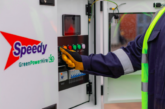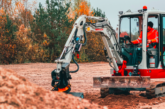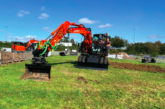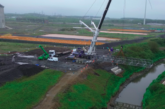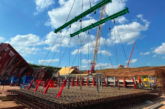Ultra-low emission temporary power equipment is becoming more widely available for construction companies, as Aggreko launches its first Stage V compliant generators to the UK market.
As part of a broader strategy to help industry reduce its environmental impact while generating energy, Aggreko has achieved its aim to become the first hire company to design and manufacture Stage V engines compliant with the Medium Combustion Plant Directive (MCPD). The MCPD is part of the European Commission’s Clean Air Policy Package to limit emissions of certain pollutants into the air from Medium Combustion Plants.
The availability of the new 600 kVA generators will aid any companies requiring temporary power when working in any of the UK’s current low emissions zones, and sets the bar when it comes to sustainable temporary power solutions.
Following extensive R&D, Aggreko’s manufacturing plant produced a prototype which was successfully trialled and have now invested in the new fleet of generators, initially to be used on a specific utilities project. The Stage V Generators enable the site to be compliant with EA legislation, and additional dispersion modelling will reduce the emissions to a minimum.
Introduced by the EU, Stage V (Regulation 2016/1628) is an emissions standard for non-road mobile machinery (NRMM) with spark/compression ignition engines. It aims to reduce emitted particulate matter and reduce harmful substances in the same way road vehicles do. It is an evolution of previous standards and requires controls, such as diesel particulate filters, to be applied to new NRMM. It limits carbon monoxide, oxides of nitrogen and hydrocarbons, as well as the mass of particulate matter (diesel soot) and number of particles emitted to the atmosphere.
To achieve this new standard, a number of significant changes have been made to Aggreko’s Stage V engines. Most notably:
- Mandatory installation of a Diesel Particulate Filter (DPF), which reduces fine diesel (DPM) emissions, also known as soot emissions.
- Selective catalytic reduction (SCR) systems utilising diesel emission fluid to reduce NOx emissions and thus comply with the standard. The technology involves injecting precise amounts of a liquid into the exhaust gases to produce a chemical reaction which neutralises harmful emissions.
- Diesel Oxidation Catalysts (DOC) with the aim of reducing CO2 emissions through the process of oxidization.
John Anderson, Sector Development Manager at Aggreko, lead the project and said: “This is a step-change for on-site temporary power generation. As the rest of the UK starts to follow London’s lead in creating low and ultra-low emission zones, it’s critical that solutions like this are readily available. We’re proud to become the first hire company to design and manufacture our own solutions in Scotland.
“An important fact is that emissions across the entire fleet must be considered. This means that when a variety of equipment is used on an entire project, the emissions across the fleet must be monitored on site. If a business is curious about whether they meet the emission standards, we will be happy to help them with these calculations and identify a suitable solution.”


